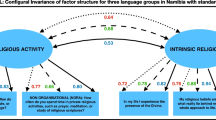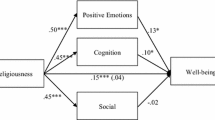Abstract
Several measures of religious practice and religious orientation (intrinsic/extrinsic/quest) and two measures of psychological well-being (positive affect and negative affect) have been employed in a cross-cultural survey of undergraduate university students from five different cultural/religious environments: Slovenia, Bosnia and Herzegovina, Serbia, the United States of America, and Japan. Results suggest that measures of exstrinsic, intrinsic, and quest religiosity are not entirely applicable in most of the cultures observed. Nevertheless, it was possible to discern abbreviated cross-culturally valid scales for each dimension. The strength and direction of the correlation between psychological well-being and a particular type of religious orientation proved to depend substantially upon culture. More importantly, the cultural environment plays a crucial role in shaping the relationship between general measures of religiosity and psychological well-being. According to the data, higher general levels of religiosity at the societal level are linked to more positive correlations between religiosity and psychological well-being. The overall picture leads to the conclusion that there is no culturally universal pattern in the relationship between measures of religiosity and psychological well-being and that the particular cultural and religious context should always be considered in studies dealing with this issue.

Similar content being viewed by others
References
Allport, G. W. (1950). The individual and his religion. New York: Macmillan.
Allport, G. W., & Ross, J. M. (1967). Personal religious orientation and prejudice. Journal of Personality and Social Psychology, 5, 432–443.
Andrade, L., Gorenstein, C., Vieira Filho, A. H., Tung, T. C., & Artes, R. (2001). Psychometric properties of the Portuguese version of the State-Trait Anxiety Inventory applied to college students: factor analysis and relation to the Beck Depression Inventory. Journal of Medical and Biological Research, 34, 367–374.
Argyle, M., & Beit-Halahmi, B. (1975). The social psychology of religion. London: Routledge & Kegan Paul.
Baker, M., & Gorsuch, R. (1982). Trait anxiety and intrinsic–extrinsic religiousness. Journal for the Scientific Study of Religion, 21(2), 119–122.
Batson, C. D., & Ventis, W. L. (1982). The religious experience: A social-subjective perspective. New York: Oxford University Press.
Batson, C. D., & Schoenrade, P. (1991). Measuring religion as quest: Validity concerns. Journal for the Scientific Study of Religion, 30, 416–429.
Batson, C. D., Schoenrade, P., & Ventis, W. L. (1993). Religion and the individual: A social-psychological perspective. New York: Oxford University Press.
Bergin, A. E. (1983). Religiosity and mental health: A critical reevaluation and meta-analysis. Professional Psychology: Research and Practice, 14, 170–184.
Bergin, A. E., Masters, K. K., & Richards, P. S. (1987). Religiousness and subjective well-being re-considered: A study of an intrinsically religious sample. Journal of Counselling Psychiatry, 34, 197–204.
Bradburn, N. (1969). The structure of psychological well-being. Chicago: Aldine.
Brewczynski, J., & MacDonald, D. A. (2006). Confirmatory factor analysis of the allport and ross religious orientation scale with a polish sample. International Journal for the Psychology of Religion, 16, 63–76.
Byrne, B. M., & Watkins, D. (2003). The issue of measurement invariance revisited. Journal of Cross-Cultural Psychology, 34, 155–175.
Davis, T. L., Kerr, B. A., & Robinson Kurpius, S. E. (2003). Meaning, purpose, and religiosity in at-risk youth: The relationship between anxiety and spirituality. Journal of Psychology and Theology, 31(4), 356–365.
Ellis, A. (1988). Is religiosity pathological? Free Inquiry, 18, 27–32.
Fehr, L. A., & Heintzelman, M. E. (1977). Personality and attitude correlates of religiosity: A source of controversy. The Journal of Psychology, 95, 63–66.
Frenz, A. W., & Carey, M. P. (1989). Relationship between religiousness and trait anxiety: Fact of artifact. Psychological Reports, 65, 827–834.
Genia, V. (1996). I, E, Quest, and fundamentalism as predictors of psychological and spiritual well-being. Journal for the Scientific Study of Religion, 35, 56–64.
Gorsuch, R. L. (1988). Psychology of religion. Annual Review of Psychology, 30, 201–221.
Gorsuch, R. L., & McPherson, S. E. (1989). Intrinsic/extrinsic measurement: I/E revised in single item scales. Journal for the Scientific Study of Religion, 28, 348–354.
Hertsgaard, D., & Light, H. (1984). Anxiety, depression and hostility in rural women. Psychological Reports, 55, 673–674.
Hishinuma, E. S., Miyamoto, R. H., Nishimura, S. T., & Nahulu, L. B. (2000). Differences in State-Trait Anxiety Inventory scores for ethnically diverse adolescents in Hawaii. Cultural Diversity and Ethnic Minority Psychology, 6(1), 73–83.
Hutchinson, G. T., Patock-Peckham, J. A., Cheong, J. W., & Nagoshi, C. T. (1998). Personality Predictors of Religious Orientation among Protestant, Catholic, and Non-religious College Students. Personality and Individual Differences, 24(2), 145–151.
Idler, E. (1987). Religious involvement and the health of the elderly: Some hypotheses and an initial test. Social Forces, 66, 226–38.
Kirkpatrick, L. (1988). A psychometric analysis of the Allport-Ross and Feagin Measures of intrinsic–extrinsic religious orientation. In D. O. Moberg & M. L. Lynn (Eds.), Research in the social scientific study of religion. Greenwich, CT: JAI Press.
Koenig H. (1993). Religion and hope for the disabled elder. In J. Levin (Ed.), Religion in aging and health (pp. 133–146). London: Sage.
Koenig, H. G. (1994). Aging and god: Spiritual pathways to mental health in midlife and later years. New York: Haworth.
Koenig, H. G. (1995). Religion and older men in prison. International Journal of Geriatric Psychiatry, 10, 219–230.
Koenig, H. G., McCullough, M. E., & Larson, D. B. (2001): Handbook of religion and health. Oxford: Oxford University Press.
Kojetin, B. A., McIntosh, D. N., Bridges, R. A., & Spilka, B. (1987). Quest: Constructive search or religious conflict? Journal for the Scientific Study of Religion, 26, 111–115.
Krause, N., & Van Tran, T. (1989). Stress and religious involvement among older blacks. Journal of Gerontology, 44, S4–S13.
Loewenthal, K. M. (1995). Mental health and religion. London: Chapman & Hall.
Makros, J., & McCabe, M. (2003). The relationship between religion, spirituality, psychological adjustment, and quality of life among people with multiple sclerosis. Journal of Religion and Health, 42(2).
Maltby, J., Lewis, C. A., & Day, L. (1999). Religious orientation and subjective well-being: The role of the frequency of personal prayer. British Journal of Health Psychology, 4, 363–378.
Musick, M. A. (2000). Theodicy and individual well-being among black and white Americans. Sociology of Religion, 61, 267–287.
Pantić, D. J. (1988). Klasična i svetovna religioznost. Beograd: Centar za politološka istraživanja I javno mnenje.
Pergament, K. I. (1997). The psychology of religion and coping: Theory, research and practice. New York: The Guilford Press.
Petersen, L. R., & Roy, A. (1985). Religiosity, anxiety, and meaning and purpose: Religion’s consequences for psychological well-being. Review of Religious Research, 27, 49–62.
Robinson, J. P., Shaver, P. R., & Wrightsman, L. S. (1991). Measures of personality and social psychological attitudes. London: Academic Press.
Shreve-Neiger, A. K., & Edelstein, B. A. (2004). Religion and anxiety: A critical review of the literature. Clinical Psychology Review, 24, 379–397.
Spellman, C. M., Baskett, G. D., & Byrne, D. (1971). Manifest anxiety as a contributing factor in religious conversion. Journal of Consulting and Clinical Psychology, 36, 245–247.
Spielberger, C. D., Gorsuch, R. L., Luchene, R., Vagg, P. R., & Jacobs, G. A. (1970). Manual for the State-Trait Anxiety Inventory. Palo Alto, CA: Consulting Psychologists Press.
Suzuki, T., Tsukamoto, K., & Abe, K. (2000). Characteristic factor structures of the Japanese version of the State-Trait Anxiety Inventory: coexistence of positive-negative and state-trait factor structures. Journal of Personality Assessment, 74(3), 447–58.
Ventis, L. (1995). The relationship between religion and mental health. Journal of Social Issues, 51, 33–48.
Watters, W. (1992). Deadly doctrine: Health, illness, and Christian God-talk. NY: Prometheus.
Wilson, W., & Miller, H. L. (1968). Fear, anxiety, and religiousness. Journal for the Scientific Study of Religion, 7, 111.
Author information
Authors and Affiliations
Corresponding author
Rights and permissions
About this article
Cite this article
Lavrič, M., Flere, S. The Role of Culture in the Relationship Between Religiosity and Psychological Well-being. J Relig Health 47, 164–175 (2008). https://doi.org/10.1007/s10943-008-9168-z
Received:
Accepted:
Published:
Issue Date:
DOI: https://doi.org/10.1007/s10943-008-9168-z




